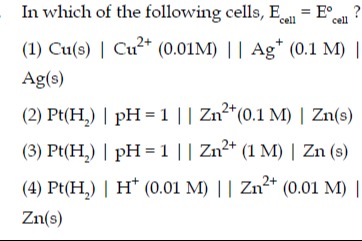Question
Question: In which of the following cells, $E_{cell}$ = $E_{cell}^{\circ}$ ?...
In which of the following cells, Ecell = Ecell∘ ?

Cu(s) | Cu2+ (0.01M) || Ag+ (0.1 M) | Ag(s)
Pt(H2) | pH = 1 || Zn2+ (0.1 M) | Zn(s)
Pt(H2) | pH = 1 || Zn2+ (1 M) | Zn (s)
Pt(H2) | H+ (0.01 M) || Zn2+ (0.01 M) | Zn(s)
(1)
Solution
The relationship between the cell potential (Ecell) and the standard cell potential (Ecell∘) is given by the Nernst equation:
Ecell=Ecell∘−nFRTlnQ
For Ecell=Ecell∘, the term nFRTlnQ must be zero. Since R,T,n,F are non-zero constants (at a given temperature), this requires lnQ=0, which means Q=1.
We need to find the cell among the given options where the reaction quotient Q is equal to 1.
Let's determine the cell reaction and the expression for Q for each cell, assuming the temperature is 298K and the pressure of gases is 1 atm unless otherwise specified.
(1) Cu(s) | Cu2+ (0.01M) || Ag+ (0.1 M) | Ag(s)
Anode (oxidation): Cu(s)→Cu2+(aq)+2e−
Cathode (reduction): Ag+(aq)+e−→Ag(s)
To balance the electrons transferred, we multiply the cathode reaction by 2:
2×(Ag+(aq)+e−→Ag(s))⟹2Ag+(aq)+2e−→2Ag(s)
Overall reaction: Cu(s)+2Ag+(aq)→Cu2+(aq)+2Ag(s)
The reaction quotient Q is given by:
Q=[Ag+]2[Cu2+]
Given concentrations: [Cu2+]=0.01 M, [Ag+]=0.1 M.
Q=(0.1)20.01=0.010.01=1.
Since Q=1, for this cell, Ecell=Ecell∘.
(2) Pt(H2) | pH = 1 || Zn2+ (0.1 M) | Zn(s)
The pH of the anode compartment is 1, so [H+]=10−pH=10−1 M = 0.1 M.
Anode (oxidation): H2(g)→2H+(aq)+2e−
Cathode (reduction): Zn2+(aq)+2e−→Zn(s)
Overall reaction: H2(g)+Zn2+(aq)→2H+(aq)+Zn(s)
Assuming standard pressure for H2, PH2=1 atm.
The reaction quotient Q is given by:
Q=PH2[Zn2+][H+]2
Given concentrations: [H+]=0.1 M, [Zn2+]=0.1 M. Assuming PH2=1 atm.
Q=(1)(0.1)(0.1)2=0.10.01=0.1.
Since Q=1, Ecell=Ecell∘.
(3) Pt(H2) | pH = 1 || Zn2+ (1 M) | Zn (s)
[H+]=10−pH=10−1 M = 0.1 M.
Overall reaction: H2(g)+Zn2+(aq)→2H+(aq)+Zn(s)
Assuming standard pressure for H2, PH2=1 atm.
Q=PH2[Zn2+][H+]2
Given concentrations: [H+]=0.1 M, [Zn2+]=1 M. Assuming PH2=1 atm.
Q=(1)(1)(0.1)2=10.01=0.01.
Since Q=1, Ecell=Ecell∘.
(4) Pt(H2) | H+ (0.01 M) || Zn2+ (0.01 M) | Zn(s)
Overall reaction: H2(g)+Zn2+(aq)→2H+(aq)+Zn(s)
Assuming standard pressure for H2, PH2=1 atm.
Q=PH2[Zn2+][H+]2
Given concentrations: [H+]=0.01 M, [Zn2+]=0.01 M. Assuming PH2=1 atm.
Q=(1)(0.01)(0.01)2=0.010.0001=0.01.
Since Q=1, Ecell=Ecell∘.
Only in cell (1) is the reaction quotient Q=1. Therefore, in cell (1), Ecell=Ecell∘.
